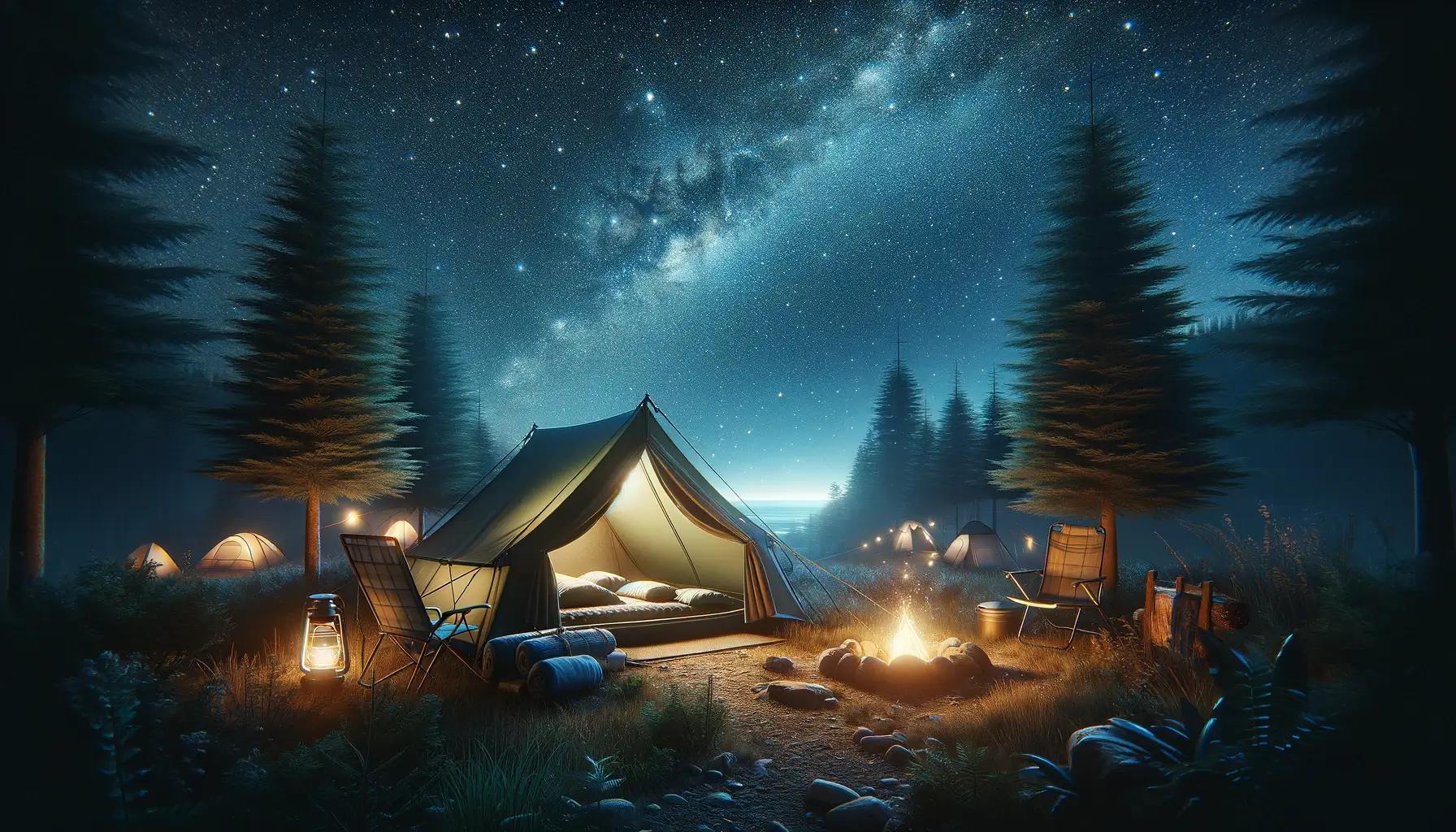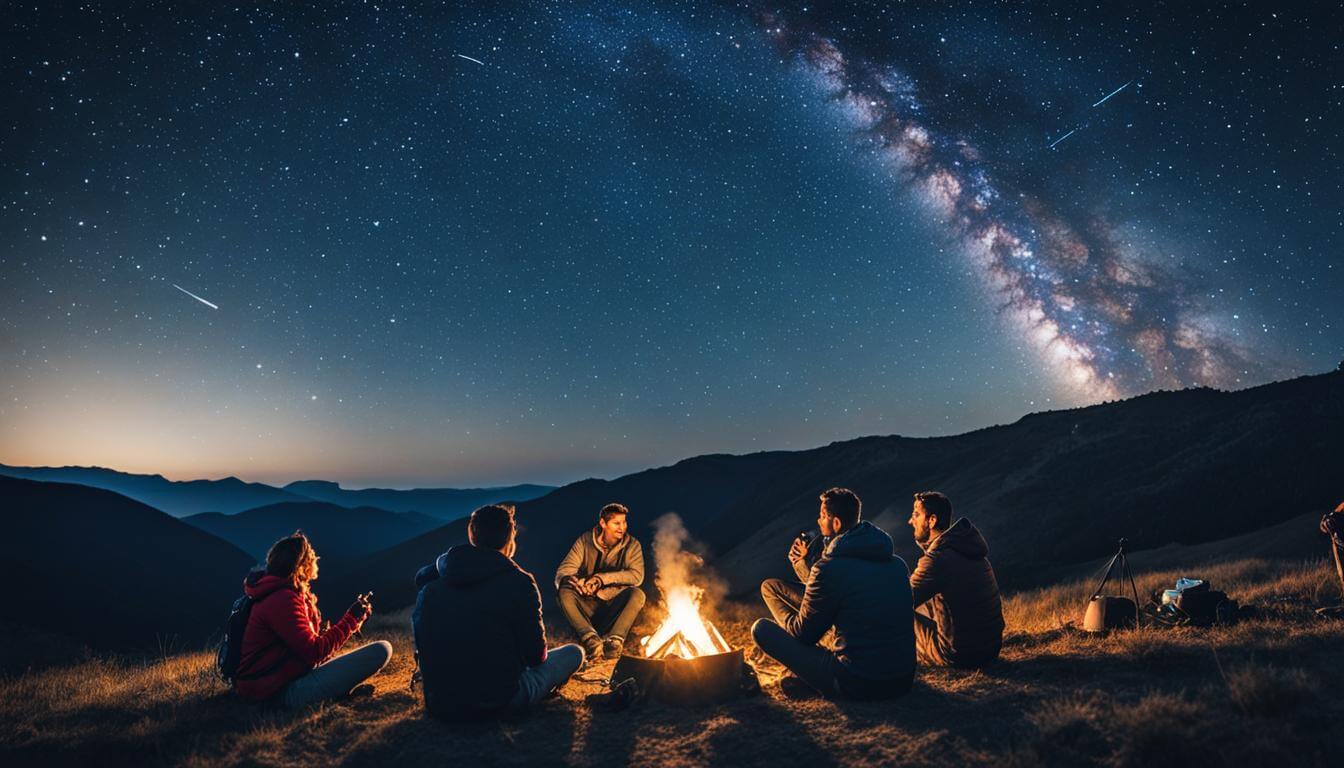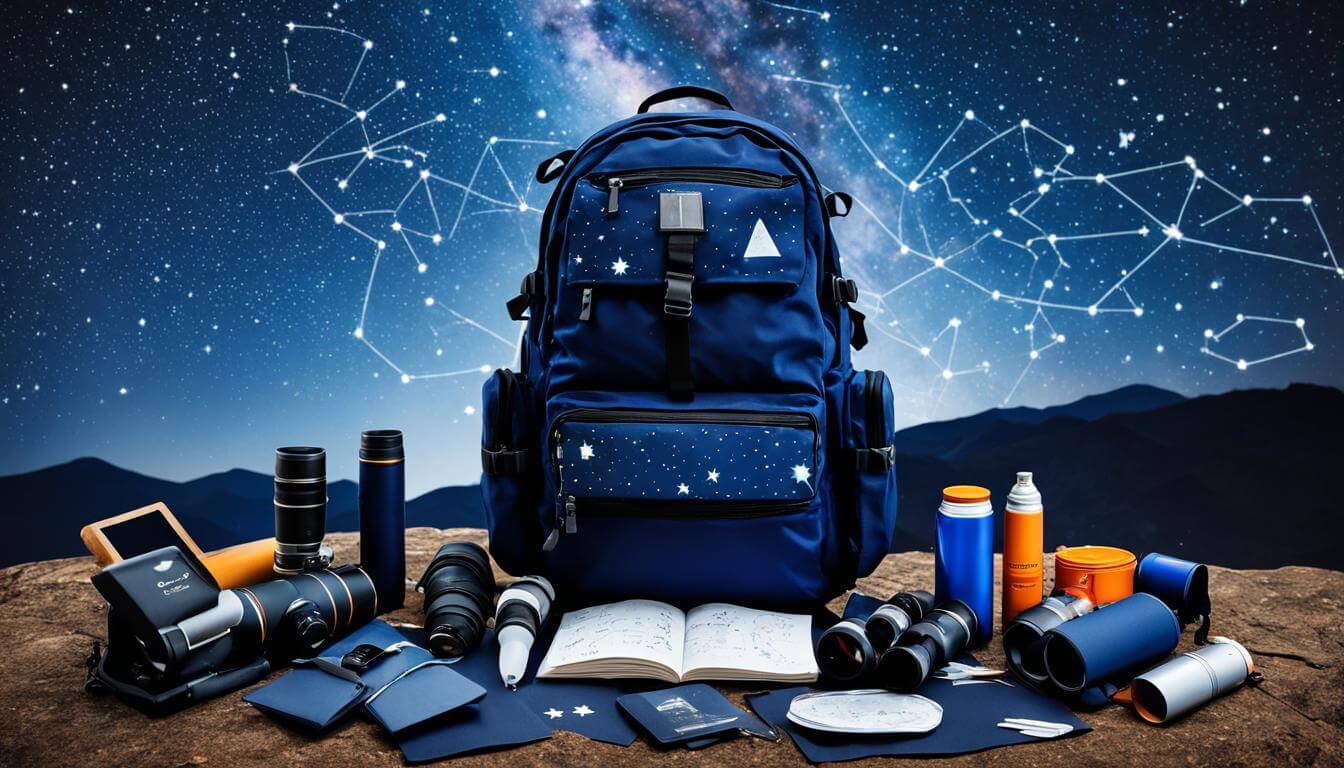Stargazing Tips: Enjoy Camping Under the Stars

Stargazing while camping under the stars is a mesmerizing experience that allows you to reconnect with the wonders of the night sky. As an avid stargazer myself, I have compiled a list of essential tips to help you make the most of your stargazing adventure. From researching constellations to choosing the right apps, I'll cover everything you need to know to have an unforgettable night under the celestial canopy.

Key Takeaways:
- Research constellations and find useful resources for a deeper understanding of the night sky.
- Utilize stellar stargazing apps to navigate and identify celestial objects with ease.
- Find the perfect stargazing spot by avoiding light pollution and considering dark sky reserves.
- Protect and enhance your night vision for optimal stargazing.
- Pack essential stargazing gear and extra comforts to enhance your experience.
Embarking on a Celestial Journey: What to Know Before You Go
Before embarking on your stargazing adventure, it's important to do some research. This will help you make the most of your celestial journey and enhance your overall experience. Whether you're a beginner or an experienced stargazer, conducting some crucial research will ensure you have the knowledge and tools necessary to navigate the night sky.
Crucial Research for the Constellation Curious
To fully appreciate the wonders of the night sky, it's beneficial to familiarize yourself with different constellations. Identifying constellations allows you to recognize patterns of stars and connect them to mythological stories and cultural lore. There are several resources available to help you in this exploration:
- Books: Look for astronomy books that provide detailed information about constellations, their history, and how to locate them in the sky. Books like "The Stars: A New Way to See Them" by H.A. Rey and "Turn Left at Orion" by Guy Consolmagno and Dan M. Davis are highly recommended.
- Websites: Online platforms provide interactive sky maps and virtual tours of the night sky. Websites like sky & Telescope and Stellarium are excellent choices for viewing and identifying constellations.
By delving into the realm of constellations through research and study, you'll be well-prepared to spot these celestial wonders during your stargazing adventure.
Choosing Stellar Stargazing Apps
In addition to books and websites, stargazing apps can be valuable tools to assist you in your celestial journey. These apps provide real-time information about the night sky, including the positions of stars, planets, and constellations. The convenience of having this information at your fingertips cannot be overstated. Here are a few noteworthy stargazing apps:
- Star Walk 2: This popular app features an intuitive interface and advanced augmented reality capabilities, allowing you to explore and identify celestial objects with ease.
- Night Sky: With Night Sky, you can point your smartphone or tablet at the sky, and the app will identify stars, constellations, and other celestial objects using augmented reality technology.
- SkySafari: SkySafari is a comprehensive app that offers detailed observations and information about the night sky. It includes features like time-travelling to witness past and future events, making it an excellent choice for astronomical enthusiasts.
By utilizing these stellar stargazing apps, you'll have a powerful resource to enhance your celestial journey and navigate the night sky with confidence.
Finding the Perfect Stargazing Spot
Finding the perfect spot is The key to a successful stargazing experience. To fully enjoy the wonders of the night sky, it is important to avoid light pollution and seek out serene locations where the stars shine brightly. Here are some tips on finding the ideal stargazing spot:
Seeking Serenity: Escaping Light Pollution
Light pollution can significantly diminish the visibility of stars and celestial objects. To escape light pollution, consider these suggestions:
- Find a location away from urban areas and major artificial light sources.
- Check light pollution maps or apps to identify areas with minimal light pollution.
- Choose a spot with a clear view of the horizon to fully appreciate the expansive night sky.
Remember, the darker the sky, the more stars you'll be able to see!
Embracing Darkness: The Lure of Dark Sky Reserves
Dark Sky Reserves are protected areas with exceptionally low levels of light pollution. These reserves offer some of the best stargazing opportunities, providing breathtaking night sky views. Here's why Dark Sky Reserves are worth considering:
"Dark Sky Reserves preserve our connection to the stars and offer a truly immersive stargazing experience. These designated areas ensure minimal light pollution, allowing visitors to witness the night sky in all its glory."
| Dark Sky Reserves | Location | Notable Features |
|---|---|---|
| Exmoor National Park | England | Milky Way visibility, wildlife spotting |
| Northumberland National Park | England | Stunning nightscapes, ancient ruins |
| Coll, Tiree, and parts of Argyll | Scotland | Unobstructed views of the cosmos, beautiful landscapes |
By visiting Dark Sky Reserves, you can immerse yourself in the beauty of the night sky and witness celestial wonders rarely visible in light-polluted areas.
Nurturing Your Night Vision for the Stars
Observing the stars requires a well-nurtured night vision. Taking certain measures can protect and enhance your ability to see the wonders of the night sky more clearly. Here are some tips to help you nurture your night vision during stargazing sessions:
- Use Red-Filtered Lights: When using a light source, opt for red-filtered lights instead of bright white lights. Red lights have a shorter weight and are less likely to interfere with your night vision.
- Allow Your Eyes to Adjust: Give your eyes time to adjust to the darkness before stargazing. Avoid looking at bright screens or lights for 10-15 minutes before heading outside. This allows your eyes to t to the low-light conditions and improve your night vision.
- Minimize Artificial Light: Avoid using cell phones or other electronic devices emitting bright light when stargazing. Even brief exposure to artificial light can significantly reduce your night vision.
- Take Breaks in the Darkness: If you need to use a light source, step away from the stargazing area and find a dark spot to illuminate your surroundings. This will prevent the light from obstructing your view of the night sky.
- Protect Your Eyes from Excessive Light: Shield your eyes from bright lights by wearing sunglasses or a hat with a brim. This will help maintain your night vision by preventing pupils from dilating too much.
Following these tips will help you preserve and enhance your night vision, allowing you to appreciate the magic of stargazing fully. So, take the necessary steps to nurture your eyes' ability to see the beauty of the night sky.
The Astronomer's Toolkit: Packing for Star-Covered Skies
Packing the right gear is essential for a successful stargazing trip. As an astronomer, here are some recommendations for your astronomer's toolkit:
Essential Stargazing Gear

- Binoculars: A good pair of binoculars can enhance your stargazing experience by bringing distant objects closer. Look for binoculars with a wide field of view and a good level of magnification, such as 8x42 or 10x50.
- Telescope: If you want to observe celestial objects in more detail, consider investing in a telescope. Choose one that suits your needs and experience level. Entry-level telescopes like the Celestron PowerSeeker 127EQ or the Orion StarBlast 4.5 Astro Reflector Telescope are great choices for beginners.
- Star Charts: Star charts are invaluable to navigate the night sky and identify constellations. They provide a visual representation of the stars and their positions. You can find star charts in bookstores or use smartphone apps like SkyView or Star Walk.
Extra Comforts for a Magical Night
In addition to stargazing gear, don't forget to pack some extra comforts to enhance your experience:
- Comfortable Camp Chair: Sitting under the stars for hours can become uncomfortable without proper seating. Invest in a lightweight and comfortable camp chair that allows you to relax and enjoy the night sky.
- Blanket or Sleeping Pad: Depending on the weather conditions and location, it can get chilly at night. Bring a warm blanket or a sleeping pad to keep yourself cosy while gazing at the stars.
- Hot Drinks and Snacks: Treat yourself to hot drinks like coffee, hot chocolate, or warm herbal tea to keep you warm during the night. Pack snacks like granola bars, nuts, or fruits to energize you.
With a well-equipped astronomer's toolkit and the added comforts, you're ready for a truly magical night under the star-covered skies. Get ready to be mesmerized by the wonders of the universe!
Discover the Sky's Spectacular Shows
The night sky holds many breathtaking displays waiting to be discovered. In this section, I'll take you on a journey through the wonders of the celestial world. From awe-inspiring constellations to dazzling star colours, the sky presents an enchanting spectacle for stargazers like yourself. Let's explore some of the mesmerizing phenomena that await your gaze.
Constellations: Celestial Patterns that Tell Stories
One of the most captivating aspects of the night sky is the presence of constellations. These patterns of stars have fueled people's imaginations throughout history, telling stories of mythical creatures, heroic gods, and ancient legends. Each constellation has a unique tale, from the majestic Orion to the graceful Cassiopeia. By learning to identify these celestial formations, you can connect with the stories of the past and appreciate the beauty that lies above.
Star Colors: A Dazzling Display of Stellar Diversity
You'll notice a stunning array of star colours when you gaze at the night sky. From shimmering blue giants to fiery red dwarfs, stars come in various hues. These colours offer insights into their temperature, composition, and stage of evolution. Marvel at the vibrant blue of Rigel, the red brilliance of Betelgeuse, or the golden glow of Vega. Observing the diverse palette of star colours is a visual feast showcasing our galaxy's richness and complexity.
The Milky Way: Our Dazzling Galactic Home
The Milky Way is one of the most awe-inspiring sights in the night sky. This luminous band of stars, dust, and gas stretches across the celestial sphere, reminding us of our place in the vast universe. The Milky Way reveals its true splendour onverse. On a clear night, away from light splendour. It takes us on a journey through the heart of our galaxy, unveiling the mysteries and wonders of distant star systems. Allowing your eyes to trace the Milky Way is a humbling experience connecting you to the cosmos's immensity and beauty.
Moon Phases: The Ever-Changing Face of Luna
The Moon, with its phases, adds another fascination to the night sky. Luna's cycle captures our imagination, from the darkness of the new Moon to the brilliant illumination of the full Moon. Each phase offers a unique viewing experience, highlighting different lunar features and creating captivating shadows across the landscape. Whether you're basking in the soft glow of a crescent moon or marvelling at the bright radiance of a full moon, the ever-changing face of Luna adds a sense of intrigue and wonder to your stargazing adventures.
Celestial Phenomena at a Glance
| Phenomenon | Description |
|---|---|
| Constellations | Patterns of stars that form recognizable shapes and tell stories from mythology and ancient cultures. |
| Star Colors | The range of colours displayed by stars, which provides insights into their temperature, composition, and developmental stage. |
| The Milky Way | A luminous band of stars, dust, and gas that stretches across the night sky, representing our galactic home. |
| Moon Phases | The changing appearance of the Moon as it goes through its monthly cycle, from new Moon to full Moon and back again. |
By immersing yourself in these celestial shows, you can deepen your appreciation of the wonders that grace the night sky. The cosmos' beauty, diversity, and grandeur are yours to explore as you embark on your stargazing journey.
Camping Under the Stars: Maximizing the Experience
Camping under the stars is a unique experience that allows you to connect with the wonders of the night sky. To make the most of this extraordinary adventure, it's important to consider timing, celestial events, weather, and seasonal considerations. By being mindful of these factors, you can enhance your stargazing experience and create lasting memories.
Timing Your Trip with Celestial Events
One of the key aspects of camping under the stars is timing your trip to coincide with celestial events. By planning your camping trip around meteor showers, lunar eclipses, or other astronomical delights sky. Research upcoming celestial events and mark them on your calendar, ensuring you choose dates that align with these extraordinary experiences.
"Camping under the stars during a meteor shower is a sight to behold. It's like nature's fireworks show, with shooting stars streaking across the sky."
At the right place and time can significantly enhance your stargazing experience. Consider consulting an astronomy guide or using stargazing apps to stay informed about upcoming celestial events.
The Importance of Weather and Seasonal Considerations
When planning a camping trip under the stars, it's crucial to consider the weather and seasonal conditions. Clear skies are essential for optimal stargazing opportunities, so check the weather forecast for your chosen camping location. Avoid camping on cloudy or rainy nights, as they can obstruct your view of the stars.
Seasonal considerations also play a role in the quality of your stargazing experience. Different seasons offer distinct celestial wonders. For example, winter nights often provide clearer skies and longer viewing hours, while summer nights may offer the opportunity to witness the Milky Way in all its glory. Research the best seasons for stargazing at your desired camping destination to maximize your chances of breathtaking celestial views.
Additionally, be aware of any local weather patterns or conditions that may affect your camping experience, such as high humidity or extreme temperatures. Properly equipping yourself and staying prepared for changing weather conditions will ensure you stay comfortable and safe while enjoying the beauty of the night sky.
Camping under the stars is truly a remarkable experience that allows you to connect with the vastness of the universe. By timing your trip with celestial events and considering weather and seasonal conditions, you can maximize your stargazing adventure. So pack your camping gear, choose the perfect location, and prepare to be captivated by the night sky's celestial wonders.
Enhancing the View: Instruments for Up-Close Observation
To truly enhance your stargazing experience, investing in the right instruments can make all the difference. Binoculars and telescopes are two popular options that can bring the wonders of the night sky closer to you. Let's explore the advantages of each and help you make an informed decision based on your preferences and budget.
Choosing Between Binoculars and Telescopes
Binoculars are a portable and versatile choice for stargazing. They provide a wide field of view, making them ideal for observing constellations, star clusters, and even the Moon. Binoculars are easy to use and navigate, making them perfect for beginners and seasoned stargazers.
Telescopes, on the other hand, offer more magnification power and can reveal intricate details of celestial objects such as planets, galaxies, and nebulae. They allow for a closer look at the universe's wondersverse, but they can be bulkier and require more setup and maintenance.
When deciding between binoculars and telescopes, consider the following:
- Portability: If you plan to take your stargazing adventures on the go or have limited storage space, binoculars are a great choice due to their compact size.
- Magnification: If you're primarily interested in observing smaller celestial objects or want to explore deep-sky objects, a telescope with higher magnification capabilities may be more suitable.
- Budget: Binoculars are generally more affordable compared to telescopes, making them a budget-friendly option for beginners. Telescopes, however, offer more advanced features and can range in price depending on their specifications.
The Convenience of Modern Stargazing with Apps
In addition to binoculars and telescopes, modern stargazing apps can further enhance your viewing experience. These user-friendly apps provide a wealth of information, allowing you to identify constellations, planets, and other celestial objects easily.
With stargazing apps, you can:
- Discover: Explore interactive sky maps that highlight the current positions of stars, planets, and other celestial phenomena.
- Learn: Access detailed information about stars, planets, and constellations, including their history, mythology, and scientific facts.
- Track: Set notifications for upcoming celestial events, such as meteor showers or planetary alignments, so you never miss out on incredible sky shows.
By combining the power of binoculars or telescopes with modern stargazing apps, you can take your stargazing adventures to new heights and immerse yourself in the beauty of the cosmos.
Dress for Success: Staying Warm and Comfortable
When it comes to stargazing, staying warm and comfortable is essential for enjoying the experience to its fullest. Spending long periods outdoors in the nighttime chill can be challenging, but you can ensure a cosy and enjoyable stargazing session with the right clothing and accessories.
Here are some tips to help you dress for success:
- Layer your clothing: Dressing in layers allows you to adjust your body temperature as needed. Start with a moisture-wicking base layer to keep you dry, add an insulating mid-layer for warmth, and finish with a waterproof outer layer to protect you from the elements.
- Wear a hat and gloves: A hat will help retain body heat by preventing heat loss from your head, and gloves will keep your hands warm and nimble for operating any stargazing equipment.
- Choose warm and comfortable footwear: Opt for closed-toe shoes or boots with good insulation to keep your feet warm and protected. Consider wearing thermal socks for extra warmth.
- Bring a blanket or sleeping pad: Sitting or lying on the ground for extended periods can be uncomfortable and chilly. A soft blanket or a foam sleeping pad can provide insulation and cushioning, ensuring comfort throughout the stargazing session.
- Use hand warmers: Hand warmers are small, portable heat sources that can fit in your pockets or gloves. They provide additional warmth and comfort during cold nights.
Remember, staying warm and comfortable allows you to focus on the beauty of the night sky without being distracted by the cold. By following these simple tips, you can ensure a pleasant and memorable stargazing experience.

Sharing the Wonders of the Night Sky
Stargazing is a captivating experience that can be further enhanced when shared with others. The joy of having stargazing companions amplifies the overall adventure and creates lasting memories. Whether you're camping with friends, family, or a significant other, the shared excitement and awe of witnessing the wonders of the night sky together deepens our connections with one another.
However, if you're looking to expand your stargazing community, connecting with astronomy clubs and attending star parties can offer exciting opportunities. Astronomy clubs bring together like-minded individuals who share a passion for the stars. These clubs often organize regular stargazing events, workshops, and lectures, providing a supportive and educational environment for stargazers of all levels.
Attending star parties is another fantastic way to mingle with fellow astronomy enthusiasts. These gatherings are typically held in dark-sky locations, away from light pollution, allowing for optimal stargazing conditions. Star parties offer a unique chance to interact with experienced astronomers, swap tips and stories, and even get a closer look at their sophisticated telescopes.
By joining astronomy clubs and participating in star parties, you can connect with passionate individuals who love exploring the night sky as much as you do. These communities provide an opportunity to learn from seasoned stargazers, share knowledge, and form lasting friendships. Together, you can embark on stargazing adventures, exchange tips and recommendations, and inspire one another to continue exploring the wonders of the universe.
Conclusion
Stargazing while camping under the stars is a truly magical experience. Following the tips and advice in this article will prepare you to embark on your celestial journey. Embrace the wonders of the night sky and create unforgettable memories in the great outdoors.
FAQ
What should I do before embarking on a stargazing adventure?
Before setting out on your stargazing adventure, it's important to do some research. Learn how to identify constellations and explore useful resources like books and websites. Additionally, consider using helpful stargazing apps to navigate the night sky.
easilyHow can I find the perfect spot for stargazing?
To find the perfect spot for stargazing, it's crucial to avoid light pollution and seek out serene locations where the night sky shines brightly. Dark sky reserves are an excellent option for stargazers, as they offer optimal conditions for stargazing.
How can I protect and enhance my night vision for stargazing?
Protecting and enhancing your night vision is essential for observing the stars. Use red-filtered lights and allow your eyes to adjust to the darkness to improve your night vision and see the wonders of the night sky more clearly.
What gear do I need for stargazing?
Essential stargazing gear includes binoculars, telescopes, and star charts. Additionally, consider packing extra comforts like a comfortable camp chair or blanket to enhance your stargazing experience.
What can I expect to see in the night sky while stargazing?
The night sky offers a host of spectacular shows, including constellations, star colours, the Milky Way, and moon phases. By knowing what to look for, you can fully appreciate the grandeur of the sky during your stargazing adventures.
How can I maximize my stargazing experience while camping?
To maximize your stargazing experience while camping, consider timing your trip with celestial events such as meteor showers and lunar eclipses. It's also important to consider weather and seasonal conditions for the best stargazing conditions.
Should I use binoculars or telescopes for stargazing?
Whether you should use binoculars or telescopes for stargazing depends on your preferences and budget. Both options have advantages, so it's important to consider what you want to observe and what level of detail you desire. Additionally, modern stargazing apps can provide a wealth of information at your fingertips.
What should I wear for nighttime stargazing sessions?
Dressing appropriately for nighttime stargazing is crucial. Layering clothing and having a blanket or sleeping pad can help you stay warm and comfortable during your stargazing sessions, allowing you to enjoy the experience fully.
Can stargazing be a shared experience?
Absolutely! Stargazing can be a shared experience that deepens connections with others. Consider inviting stargazing companions to join you on your celestial journey. Additionally, connecting with astronomy clubs and attending star parties can provide opportunities to meet fellow enthusiasts and learn more about the night sky.
